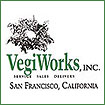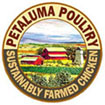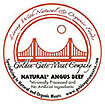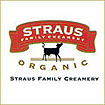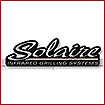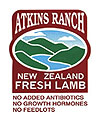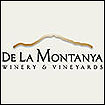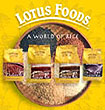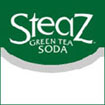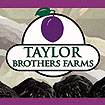
Abalone's Luster Grows
Eco-friendly
aquaculture lures endangered mollusk back
onto Bay Area Menus
By Olivia Wu - San Francisco
Chronicle Writer
Photo Illustration - Craig Lee
Shortly before it ends in the ocean, Municipal
Wharf No. 2 in Monterey Bay runs through
a seafood warehouse that looks like a
garage. A man paces by the front door,
waiting. Sure enough, in 10 minutes, a
trap door in the middle of the floor swings
open and a tall, lanky fellow wearing
rubber boots springs up the ladder.
It's
Art Seavey, 49, co-owner of Monterey Abalone
Co. At first glance, it looks like he
is holding a handful of gray rocks, but
they're live abalone. He gently lays them
on a sheet of foam inside heavy plastic,
clamps the bag, pumps in oxygen and seals
it. He hands the package to the customer,
takes cash, thanks him and waves him goodbye.
Then it's back down the trapdoor to the
ocean below where Seavey has a system
of cages and pulleys to harvest the abalone.
Although
they work mostly in isolation and obscurity,
10 years after the ban on commercially
harvesting wild abalone went into effect,
local growers are successfully producing
the unique seafood delicacy.
California
now has 15 abalone farms, constituting
a business that, over the last seven or
eight years, "has flourished and
become more of a standard farming procedure,"
says Roy Gordon of FishTech, a worldwide
abalone-farming consulting firm based
in San Rafael.
Farmed
abalone is the only type available for
retail sale, although private divers may
still hunt for abalone according to a
strictly enforced quota.
Four-star
restaurants such as the French Laundry
in Yountville and Manresa in Los Gatos
are putting farmed abalone on their menus,
and Bay Area Cantonese- and Hong Kong-style
restaurants -- where fresh means live
-- display the shellfish in tanks.
Thomas Keller of the French Laundry uses
them occasionally, and most often in a
scallopine (a gently pounded steak) preparation.
David
Kinch of Manresa uses abalone regularly
on his fixed-price menu. He says they
are more tender than wild abalone.
Still,
abalone farmers struggle in obscurity,
and do battle on many fronts.
The
farms, such as Monterey Abalone Co., are
often invisible, with "livestock"
hidden under water. Customers come from
a small and dedicated base -- predominantly
private Asian buyers or fine-dining restaurants.
The farmers are lone figures cleaning
and hauling cages out of water to cull
and feed their critters; by dawn, they
harvest tons of wild kelp from the ocean
as feed for their farms. Seavey spends
his days in the underworld of the city's
pier, walking on planks between the pilings.
He's
buffeted by the elements as well as strict
regulations from state agencies. Yet the
Monterey Bay Aquarium's Seafood Watch
list awards farmed abalone a green light
for good use of environmental resources;
low risk for disease and escape, impact
on habitat and pollution; and management
practices.
"Aquaculture
has been painted with a very negative
brush because of the negative effects
of salmon farming,'' says Corey Peet,
aquaculture analyst with the aquarium,
but "all aquaculture is not created
equal. Abalone is at the upper end of
the good scale."
Californians
are wary of fish farms. On top of that,
there is the not-in-my-backyard attitude,
says Peet.
Coastal
property in California is some of the
most expensive in the world, and owners
protect their views. Seavey and other
farmers, such as the soon-to-open Doug
Hayes' California Abalone Co. in Half
Moon Bay, have permits to harvest seaweed
but say that they are dogged by residents
who see them gathering kelp and report
them to law enforcement. Kelp, which grows
in forests in Monterey Bay, is the conventional
feed for abalone.
"It's
like hay on a farm," says Seavey.
In certain seasons, it grows 6 feet a
day. When abalone farmers harvest kelp,
which the state licenses them to do, they
cut only the top and are not killing the
plant; it's a sustainable system.
"I'm
just mowing the kelp beds," says
Hayes, who has been nursing his operation
along for 10 years, and may begin to sell
from his boat later this summer.
Some
abalone farms are located inland. In this
system, the abalone are usually raised
in concrete tanks with fresh sea water
pumped in, the method that US Abalone
in Davenport (Santa Cruz County).
Abalone
and oyster farming are two aquaculture
systems that, when done correctly, leave
little or no negative environmental effects.
"It couldn't be more natural. Healthy
ocean water and kelp are the main ingredients,"
says Gordon.
Seavey's
operation leaves as light an environmental
"footprint," as ecologists say,
as possible. Monterey Bay has a complete
surge, or change of water, every 12 hours,
and a strong current flows through continuously,
"so there's never stagnant water,"
he says. His system of cages and the design
of the sub-pier walkways relies on the
two natural high tides that sweep in to
keep the abalone healthy and to wash out
their natural waste. The waste in turn
is natural fertilizer for the abundant
kelp forests of Monterey Bay.
Seavey
has spent a lifetime involved in farming
of one sort or another. He was raised
in a wine-making family (Seavey Vineyard
of St. Helena), studied ecology at UC
Davis and then traveled the world, looking
at various farming operations. In the
1980s, he went to Ecuador to learn shrimp
farming. Within 10 years, the industry
died, the victim of its own unsustainable
practices. Seavey watched the terrible
environmental effects of that industry.
He
returned to California, determined to
find an aquaculture system that would
balance ecology and commerce. In 1994,
he became a partner in the fledgling Monterey
Abalone Co.
Time
itself is the final battle for abalone
farmers. Abalone grow slowly. While it
is a luxury product, it takes a minimum
of three years to grow Haliotis rufescens
or "red" abalone, one of the
seven breeds native to California and
the one most commonly raised, to saleable
size -- 3- to 3 1/2-inches. It takes five
years to grow it to the 5-inch size (about
1 pound), and eight years to reach the
7-inch size.
Only
35 to 40 percent of the total weight of
an abalone is edible. The rest is mostly
shell. But of that edible part, some 65
percent is protein. Other nutrients include
selenium, magnesium and iron, and some
omega-3 fats. Abalone is also relatively
high in cholesterol and salt.
Abalone
start-up operations take at least five
to six years before there's anything to
sell. The growing process begins with
seed abalone, usually the size of a thumbnail.
During the course of their growth, they
are culled and moved to ever-bigger cages
and fed more food. Seavey purchases his
seed. Others, such as US Abalone, grow
their own seed from egg and sperm released
by adult abalone in clean ocean water.
All
this means that abalone doesn't come cheap.
An entree of two 4-inch abalone steaks
can cost $50-plus. Purchased raw, smaller
abalone (in-shell) costs $20 per pound;
the price increases as the abalone size
increases.
As
abalone farms continue to flourish, the
price should come down to the cost of
live lobster. The American production,
largely from California, is a tiny part
of the world supply, in part because of
strict regulations and of soft local demand.
"It's
a major industry in world but in the United
States, there is limited land near water,
and it's in private hands," says
Gordon of FishTech.
Meanwhile,
today's California product is as good
as farmed seafood can get. Seavey's operation
is a model, a "very unique and very
special operation," says Gordon.
"They can watch their abalone so
closely and yet use the water in the bay
to go through the cage. It's a very efficient
and very natural operation."
Handling
abalone
Abalone is extremely perishable, and should
be kept refrigerated and used within 3
days.
To
shuck abalone, use an offset spatula,
and slide under the foot of the abalone
and pry from the shell. Remove the digestive
system from around the edge. With a sharp
paring knife, find the bony "mouth"
and cut off. Rinse off abalone, making
sure to remove all digestive organs. Rinse
the shells, and reserve them if needed.
To
tenderize the abalone, lay out a dish
towel on a sturdy table or butcher block.
Remove
the abalone from the fridge and, holding
a sharp knife at a wide angle, make crosscut
incisions about 1/4-inch apart and 1/4-inch
deep on the bottom of the foot of the
abalone.
Place
the abalone foot side down on the edge
of the dish towel and fold the other edge
of the towel over the abalone to completely
cover them. Pound each abalone two to
three times gently but firmly with the
flat side of a meat tenderizer. You should
slightly flatten the abalone without disfiguring
or splitting it.
To
see a video of how to shuck and tenderize
abalone, click
here.
Abalone Resources
Fresh abalone are available from the following
sources. The farms sell direct, or will
ship, generally overnight. In addition,
some Asian markets throughout the Bay
Area carry abalone, especially around
big holidays, although it is often imported
from Mexico. Some seafood retailers can
also order California-grown abalone for
you.
The
Abalone Farm. Cayucos
(San Luis Obispo County); (805) 995-2495
or (877) 367-2271, or www.abalonefarm.com.
Cultivated offshore. Live in-shell abalone.
Also pre-shucked and tenderized fresh
or frozen steaks.
Monterey Abalone Co.
160 Municipal Wharf No. 2, Monterey; (831)
646-0350 or www.montereyabalone.com.
Cultivated in Monterey Bay. Live in-shell
abalone.
US
Abalone. 245 Davenport
Landing Road, Davenport; (831) 457-2700
or www.usabalone.com.
Cultivated offshore. Live in-shell fresh
abalone in three sizes; frozen abalone
available at Saturday farmers' market
in Davenport (San Mateo County) from 10
a.m.-2 p.m. (Note: US Abalone is for sale;
the current manager-owner expects production
to continue as usual.
Abalone
Recipes:
Koi
Palace's Abalone Poached in Rich Sauce
Serves
4
INGREDIENTS:
4 3- to 4-inch fresh abalone, in their
shells (about 4-5 ounces each, including
shell)
2 cups chicken stock
2 ounces Smithfield or serrano ham, or
prosciutto, cut into 4 pieces, or 1 ham
hock
1 tablespoon reduced rich beef or veal
stock, or demi-glace (see Note)
2 teaspoons oyster sauce
1 teaspoon artisanal soy sauce
1 teaspoon teriyaki sauce
1/4 teaspoon sugar
1 tablespoon minced green onion
1 teaspoon cornstarch
1 teaspoon water
INSTRUCTIONS:
Instructions: Shuck and tenderize abalone
according to instructions on this page.
Reserve shells. Refrigerate until needed.
Bring
chicken stock to a simmer in a wok. Add
ham, simmer for 45 minutes, or until reduced
to 1 cup. Add 1/4 cup water if stock reduces
too quickly. This stock may be made ahead
and refrigerated.
Remove
ham and discard. Add rich beef stock,
oyster sauce, soy sauce, teriyaki sauce,
sugar and half of the green onion to the
reduced chicken stock. Bring to simmer,
and add abalone. Poach (do not boil) for
1 minute, or until the abalone is just
done. Scoop out the abalone with a slotted
spoon and place in the reserved shells.
Make
slurry with cornstarch and 1 teaspoon
water, stirring until combined. Add just
enough to the stock and stir until it
just holds together and becomes translucent.
Spoon the sauce over the abalone, letting
some sauce fall decoratively on the plate.
Sprinkle with the remaining green onion
and serve immediately.
Note:
Rich beef or veal stock or demi-glace
(frozen) are available at well-stocked
markets.
Per
Serving: 55 calories, 6 g protein, 6 g
carbohydrate, 0 fat, 18 mg cholesterol,
429 mg sodium, 0 fiber.
Manresa's
Abalone, Meuniere Style
Serves
4
A
classic technique from chef David Kinch
of Manresa in Los Gatos, which gives the
abalone only the mildest pounding, leaving
it a good 1/2 inch thick. You must purchase
the abalone the day before so that it
can "relax" overnight after
shucking.
NGREDIENTS:
4 small abalone, in their shells (about
4-5 ounces each,
including shell)
1 cup all-purpose flour
6 tablespoons unsalted butter
1 tablespoon finely chopped Italian parsley
1 tablespoon Meyer lemon juice
Fleur de sel, or sea salt
INSTRUCTIONS:
The day before: Shuck the abalone according
to instructions on this page. Put the
abalone on a plate, cover with plastic
wrap and place in the refrigerator overnight.
This will relax the abalone and prevent
it from splitting when it is pounded.
The
day of serving: Tenderize the abalone
according to instructions on this page.
Return the abalone to its plate and cover
with plastic wrap.
When
ready to serve, toss each abalone in flour,
shaking off excess. Do not season with
salt; abalone tend to have a high natural
salinity.
Heat
the butter in a saute pan over medium-high
heat. When the butter stops sizzling and
begins to foam, add the abalone foot-side
up to the pan. Gently shake the pan constantly
and allow the butter to slowly turn a
hazelnut brown with a nutty aroma.
fter
about 2 minutes, turn the abalone and
saute another minute on the foot side.
The abalone and the butter should both
be nutty brown. Add the parsley and lemon
juice and shake the pan to coat with the
juices.
Place
the abalone on a plate and spoon some
of the lemony juices over each serving.
Adjust seasoning with a pinch of fleur
de sel or sea salt, if needed.
Per
Serving: 210 calories, 5 g protein, 9
g carbohydrate, 18 g fat (11 g saturated),
64 mg cholesterol, 63 mg sodium, 0 fiber.






















